Ergonomic workplace - tips for ergonomics
Everything to do with ergonomics
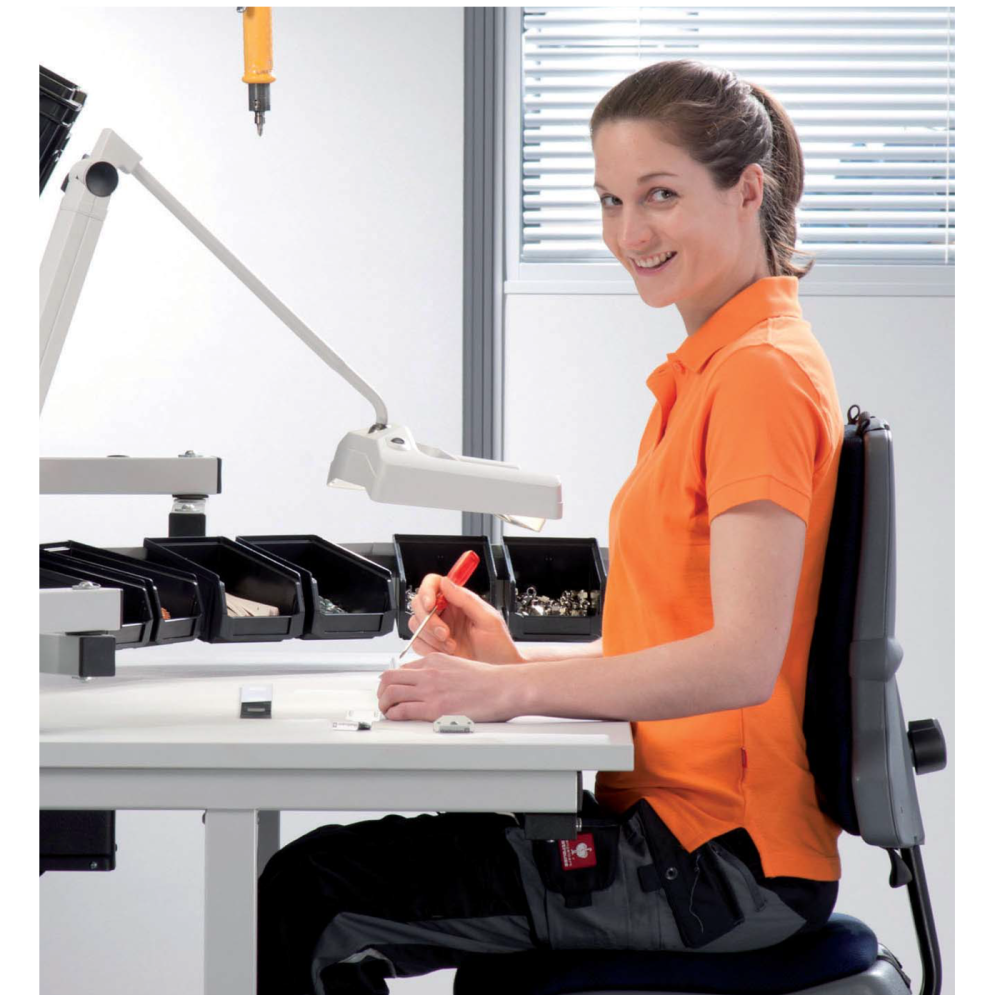
Impulses for ergonomics at the workplace
It is the shared vision that has motivated three market leaders to embark on a co-operation project: Ergonomically optimised work concepts that benefit employers and employees alike.
teamwork Forum workplace design is an initiative of the companies bimos, KARL and Waldmann. The innovative product portfolio in the areas of desks, chairs and lighting forms the basis for ergonomic workplace design in a wide range of industries.
The three companies, which manufacture and develop in-house, are close to the market and to the needs of everyday working life.
One thing has always been very clear: The ergonomic design of working environments has a direct impact on the quality of the work performed and the performance of employees. Improved quality in production and reduced absenteeism have direct economic benefits. This is why more and more companies are actively using ergonomics as an element of sustainable value creation.
For more health, safety, productivity and motivation
Ergonomics is the science of the laws of human labour. The term is made up of the Greek words ergon (labour, work) and nomos (law, rule). Ergonomics is a complex system for adapting work equipment and work scenarios to the needs of people.
The benefits are manifold. Employees are more motivated and more productive and are protected from health problems, even when carrying out their work for long periods of time. Scientific studies also show that ergonomically optimised working environments increase productivity and the quality of the work performed.
Ergonomics includes the following aspects:
- Humanity - impairment-free and healthy working conditions
- Productivity - quality and profitability of performance
- Motivation and satisfaction - employee expectations
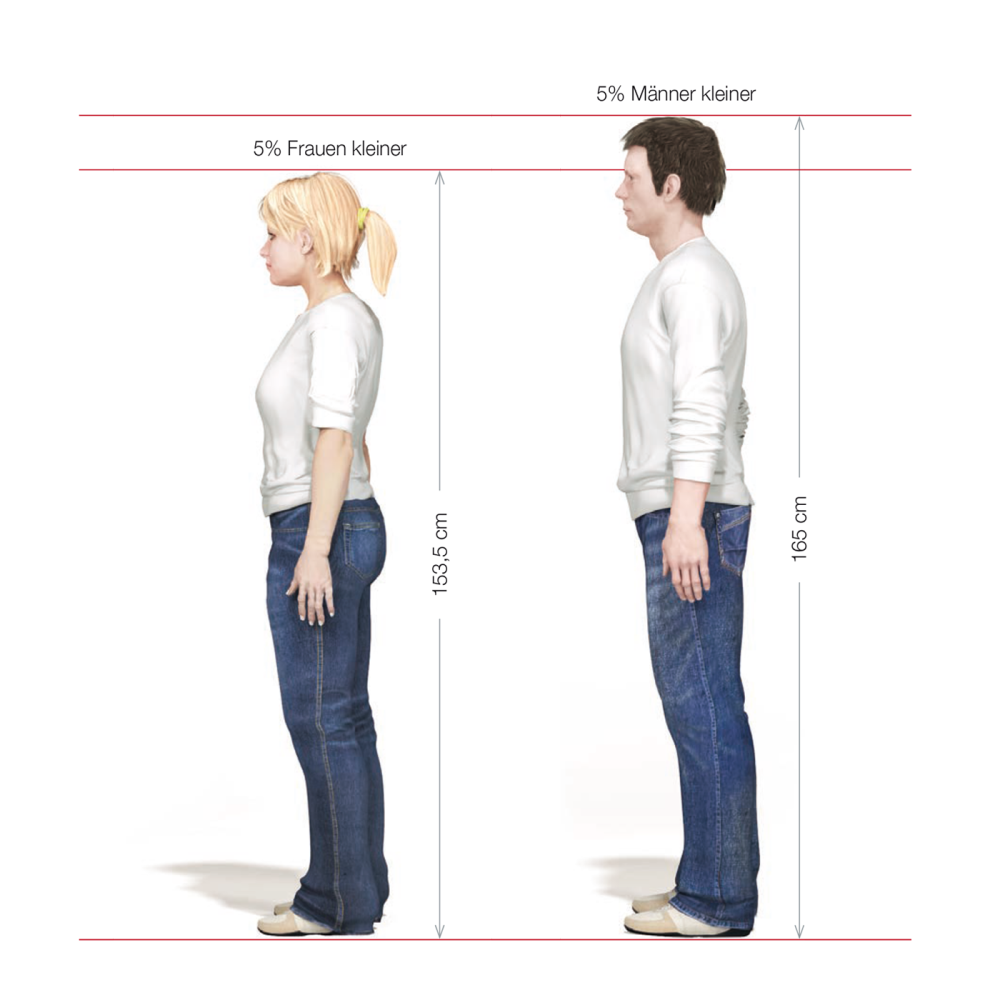
The measure of all things: our body.
The basis for the ergonomic design of the workplace is the person - their body (height, weight, movement sequences, etc.), their sensory perceptions (light, noise, temperature) and their intellectual abilities (e.g. information processing, attention, creativity).
Human body measurements (anthropometry) are used as a basis to do justice to anatomical concerns with regard to ergonomic workplace design. However, if the entire range of variation in the population were to be taken into account, it would not be possible to derive a practicable ergonomic workplace design. Therefore, the upper and lower 5 % percentiles of the overall distribution are removed.
Overall, body measurements from the 5th percentile of women to the 95th percentile of men are taken into account.
Solutions that do justice to our anatomy
This results in a variation range of 32 cm for body height, which represents 90 % of the population. The requirements for optimum ergonomic workplace design are derived from this "confidence interval".
Individualised special solutions are required for people who do not fall into this category.
All measurements apply to unclothed persons. Appropriate surcharges are required for workwear and protective clothing.
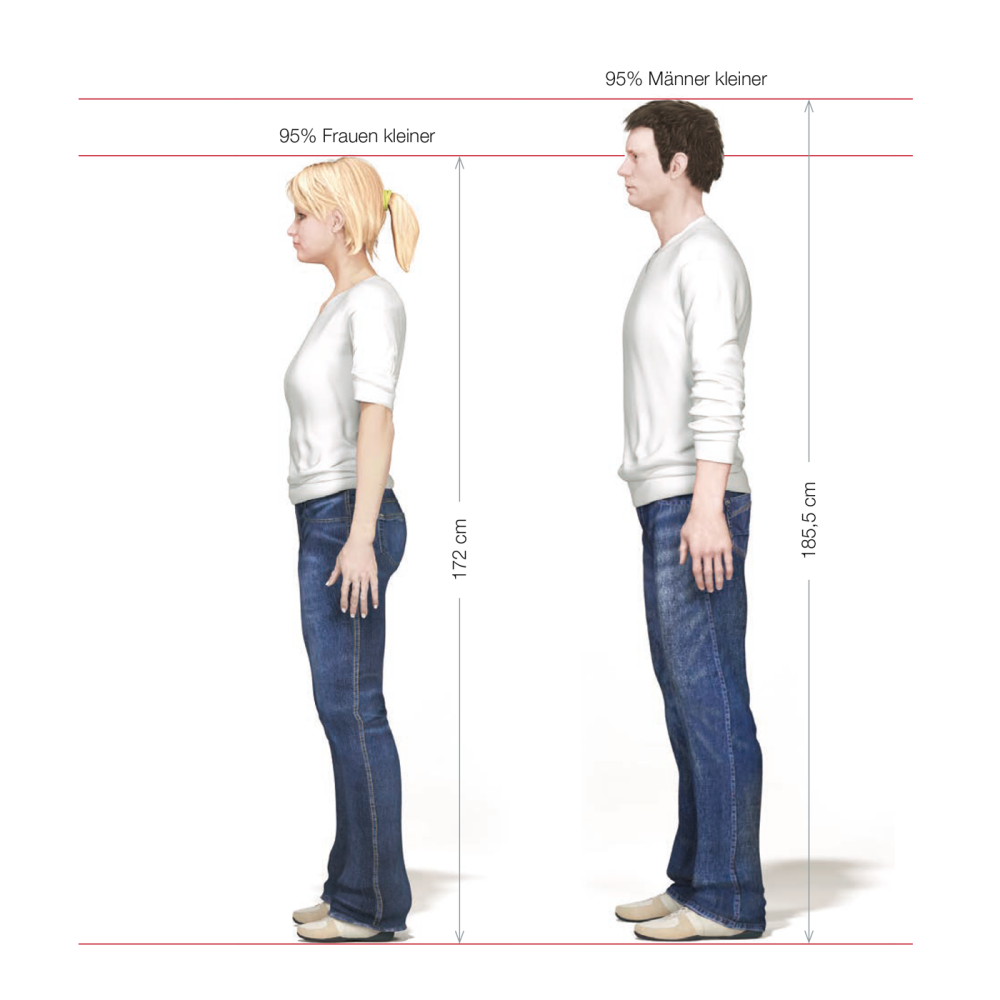
DID YOU ALREADY KNOW? - PERCENT VALVE
Percentile (hundredth percentile) is a statistical term that divides an overall distribution into 1 % segments. The nth percentile denotes the limit value below which n % of the total measured values lie.
For example, the 5th percentile indicates that 5% of the total values are below this limit. The 95th percentile says that 95% of the total values are below this limit, i.e. 5% above it.
Due to the so-called normal distribution, this means that although only 25 % of the total range of variation in body heights is taken into account, 90 % of people are covered.
What doesn't fit is made to fit
The requirements for the working environment in which activities such as sitting, standing, seeing or reaching are carried out are derived from the body measurements - especially the body heights.
As workstations in assembly and production are generally used by different people (e.g. in shift work, job rotation or one-piece flow), it must be possible to adjust them to individual dimensions. This is because body heights can vary greatly - and even with the same or similar heights, individual proportions can differ significantly.
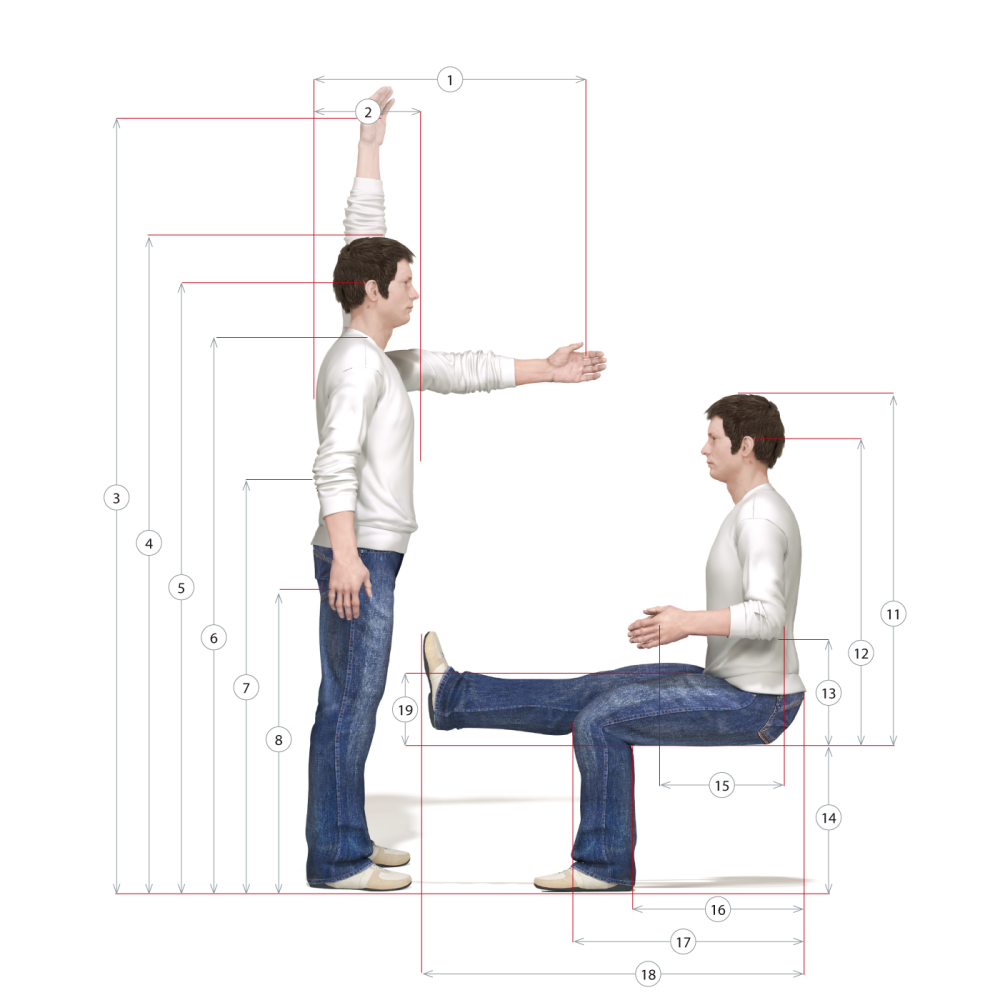
Solutions for individual proportions
Unless certain production processes dictate otherwise in terms of dimensions, the dimensions and arrangement of elements at the workstation are based on the requirements of anthropometry and physiology.
Wherever possible, work equipment should be used that is adjustable and can be adapted to individual body heights and proportions. If the workstation and work equipment are not optimised to the employee's body dimensions and activity, this will lead to forced postures in the long term.
This in turn leads to strain and one-sided wear and tear. For example, tendons or muscles, nerves, tissue, heart and circulation are affected. Possible consequences are painful tension, muscle and tendon shortening, heart and circulatory diseases.
This not only harms the employee - it also represents a reduction in value-adding work performance.
All measurements apply to unclothed persons. Appropriate allowances are required for work and protective clothing. For workplace design, the measurements of the tallest man are to be used for internal dimensions (e.g. legroom) and the measurements of the smallest woman for external dimensions.
All measurements apply to unclothed persons. Appropriate allowances are required for workwear and protective clothing. For workplace design, the measurements of the tallest man are to be used for internal dimensions (e.g. legroom) and the measurements of the smallest woman for external dimensions.
| Body dimensions | |||||||
| (according to DIN 33402 - dimensions in cm) | 5% | 50% | 95% | ||||
| ♀ | ♂ | ♀ | ♂ | ♀ | ♂ | ||
| 1. | Forward reach | 62,5 | 68,5 | 69,0 | 74,0 | 75,0 | 81,5 |
| 2. | Body depth | 24,5 | 26,0 | 29,0 | 28,5 | 34,5 | 38,0 |
| 3. | Range upwards | 184,0 | 197,5 | 194,5 | 207,5 | 202,5 | 220,5 |
| 4. | Body height | 153,5 | 165,0 | 162,5 | 175,0 | 172,0 | 185,5 |
| 5. | Eye level | 143,0 | 153,0 | 151,5 | 163,0 | 160,5 | 173,5 |
| 6. | Shoulder height | 126,0 | 134,5 | 134,5 | 145,0 | 142,5 | 155,0 |
| 7. | Elbow height above the standing surface | 96,0 | 102,5 | 102,0 | 110,0 | 108,0 | 117,5 |
| 8. | Height of the hand above the standing surface | 67,0 | 73,0 | 71,5 | 76,5 | 76,0 | 82,5 |
| 9. | Hip width standing | 34,0 | 34,0 | 36,5 | 36,0 | 40,0 | 38,5 |
| 10. | Shoulder width | 39,5 | 44,0 | 43,5 | 48,0 | 48,5 | 52,5 |
| 11. | Seat height | 81,0 | 85,5 | 86,0 | 91,0 | 91,0 | 96,5 |
| 12. | Eye level when seated | 70,5 | 74,0 | 75,5 | 79,5 | 80,5 | 85,5 |
| 13. | Elbow height above the seat | 18,5 | 21,0 | 23,0 | 24,0 | 27,5 | 28,5 |
| 14. | Length of lower leg with foot (seat height) | 37,5 | 41,0 | 41,5 | 45,0 | 45,0 | 49,0 |
| 15. | Elbow-grip centre distance | 29,5 | 32,5 | 31,5 | 35,0 | 35,0 | 39,0 |
| 16. | Seat depth | 43,5 | 45,0 | 48,5 | 49,5 | 53,0 | 54,0 |
| 17. | Buttock-knee length | 54,5 | 56,5 | 59,0 | 61,0 | 64,0 | 65,5 |
| 18. | Buttock-leg length | 92,5 | 96,5 | 99,0 | 104,5 | 105,5 | 114,0 |
| 19. | Thigh height | 12,5 | 13,0 | 14,5 | 15,0 | 17,5 | 18,0 |
| 20. | Width above the elbow | 39,5 | 41,5 | 48,5 | 48,0 | 55,5 | 55,5 |
| 21. | Hip width sitting | 36,0 | 35,0 | 39,0 | 37,5 | 46,0 | 42,0 |
DID YOU ALREADY KNOW? - ANTHROPOMETRY
Anthropometry (from the Greek "anthropos" - man; "metron" - measure) is the science of determining and applying the measurements of the human body. It is primarily used for the ergonomic design of workplaces and products such as vehicles, tools and furniture.
The PhysiologyBiology, a branch of biology, is the study of the physical and biochemical processes of cells, tissues and organs and their interaction in the organism as a whole.
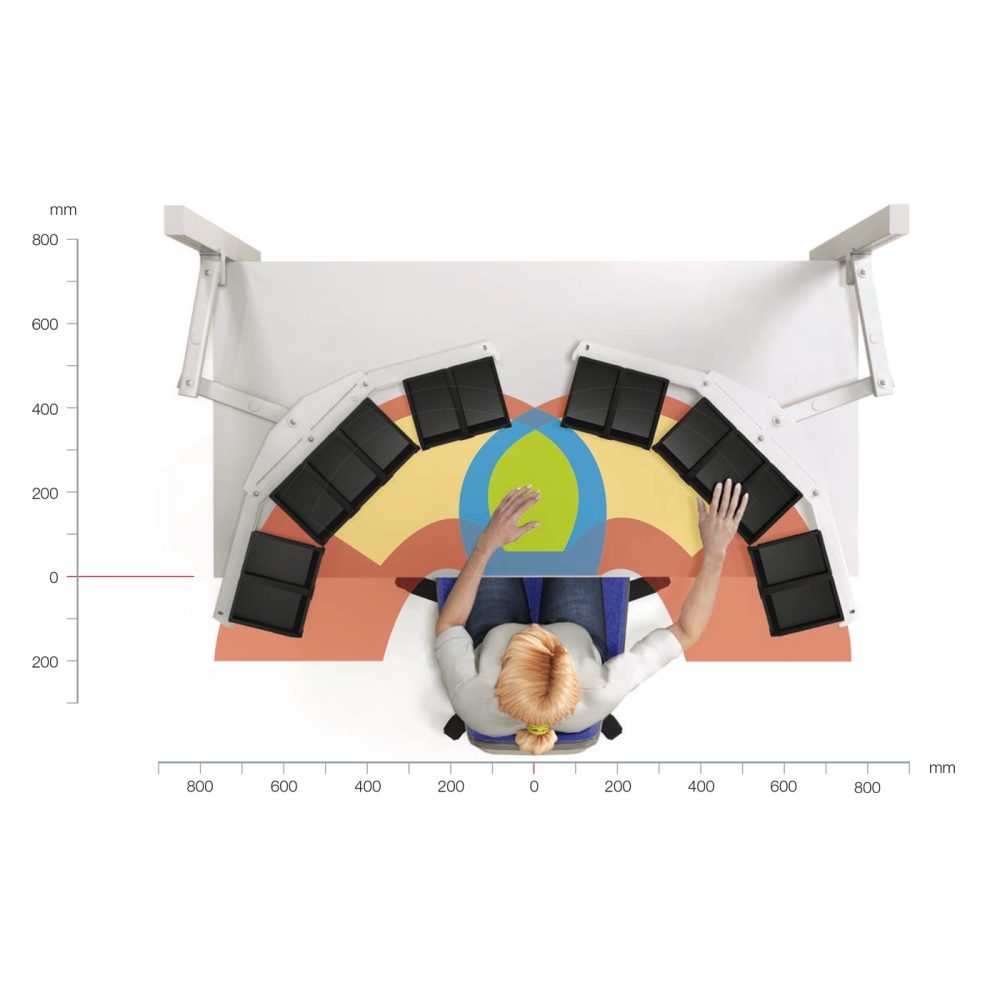
Understanding with your hands
The gripping space
Zone 1: Work centre
Hands working close together - assembly site
Zone 2: Extended work centre
Both hands reach all points of this zone
Zone 3: One-hand zone
For storing parts and tools that are often gripped with one hand
Zone 4: Extended one-hand zone
Outermost usable zone, for example for grab containers
The area that can be reached with the hands without leaving your position is known as the reach zone. A distinction is made between the inner reach area, which can be reached with bent arms, and the outer reach area, which can be reached with outstretched arms.
To enable an ergonomic movement sequence, frequently used parts are arranged in the inner gripping area and less frequently used parts in the outer gripping area. All necessary containers, devices and operating elements are arranged in such a way that a flowing, curved upward movement is created, pointing away from the body. This prevents the upper body from having to be turned - unnecessary shoulder movements and one-sided and repetitive movements are avoided.
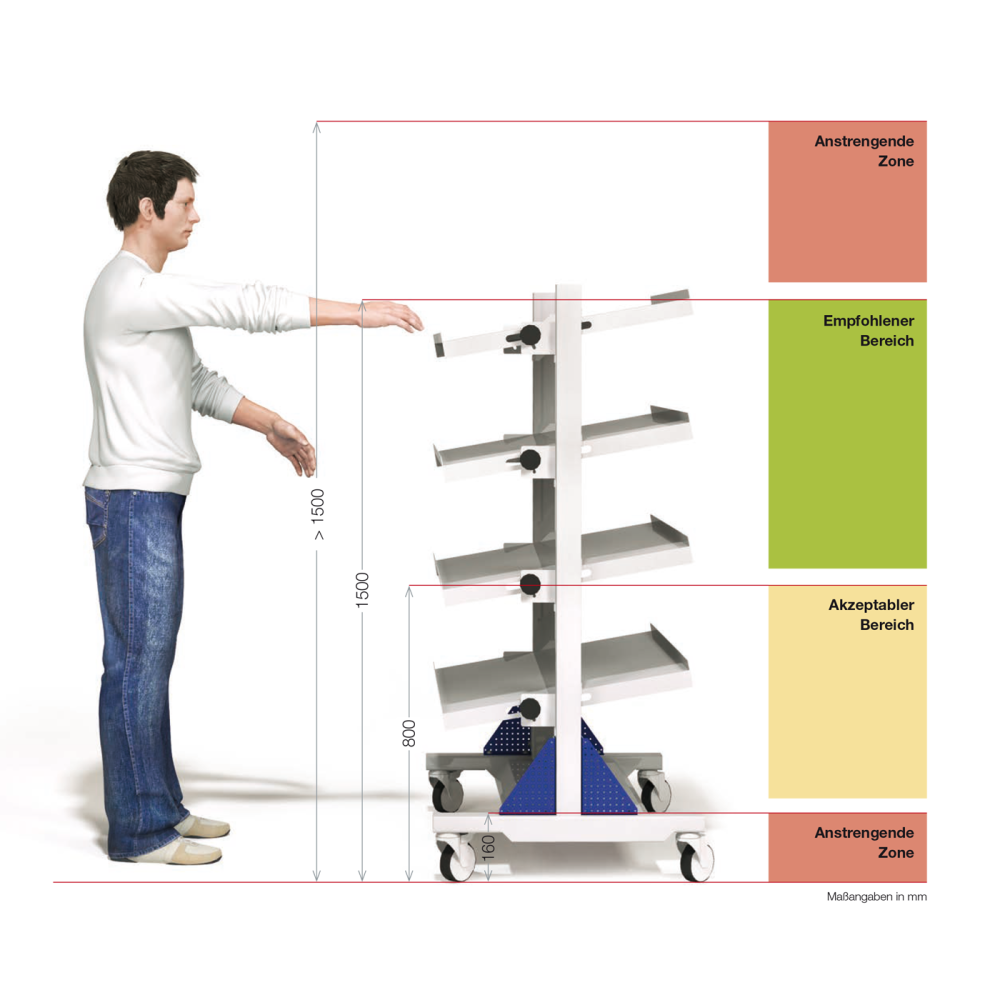
The comfortable working height
DID YOU ALREADY KNOW? - IDEAL WORKING HEIGHT
The ideal working height is between 800 mm and 1500 mm.
Working above heart level (over 1500 mm) reduces blood circulation and thus the oxygen supply to the muscles.
Activities that require bending less than 800 mm are also disproportionately stressful and should be avoided.
Sitting correctly needs to be learnt
The same applies to task chairs:
The task chair adapts just as well to the work situation as it does to the person and is extremely comfortable.
Despite its ideal industrial suitability, a good task chair makes no compromises in terms of its ergonomic properties. What was previously reserved for office workstations is now also a must in production: optimum body support, an excellent sitting climate and maximum comfort.
At production workstations, people work with force or fine motor skills, movement sequences are repetitive and it is not always possible to adopt an ideal posture in relation to the workpiece. In order to enable active, dynamic sitting and prevent forced postures, a chair must adapt perfectly to the working environment and to the individual in order to protect the health and performance of employees.
There are basically two mechanical concepts to choose from:
the permanent contact backrest and synchronised technology.
The Permanent contact backrest follows the person's movements and ensures that the back is always ideally supported. The weight regulation ensures that the backrest resistance and body weight are always in balance. The permanent contact backrest is particularly suitable for predominantly forward-leaning work with little distance between the workpiece and eyes (e.g. in precision mechanics or in the laboratory).
The Synchronisation technology ensures active, dynamic sitting including weight regulation. The seat and backrest accompany the body as it moves. This creates a feeling that can probably best be described as "weightless gliding". The synchronised technology really comes into its own in office-like work situations, when working at a computer screen and in frequently changing sitting positions.
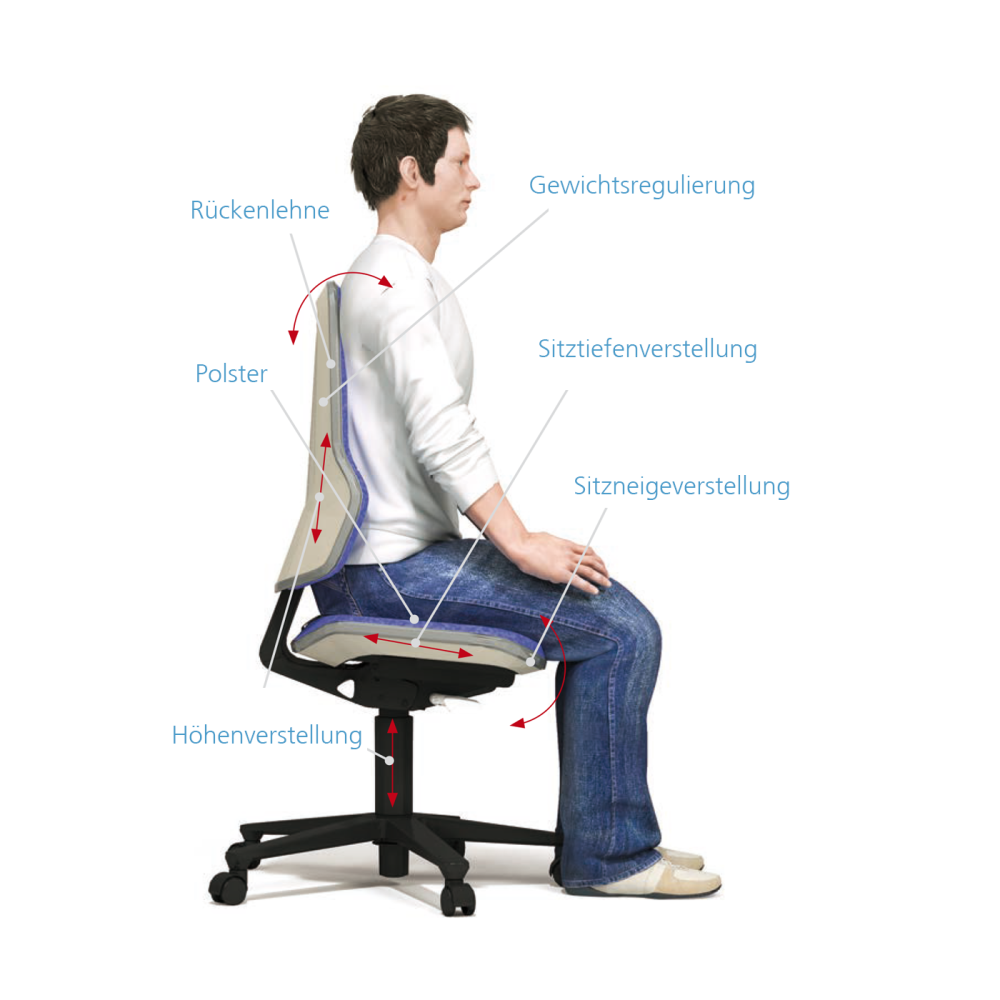
The right chair
Backrest
In contrast to workstations in the office, it is always important to ensure maximum freedom of movement with task chairs. To make this possible, the backrest should taper upwards.
Upholstery
Interchangeable pads are a very important factor for reasons of hygiene and economy. Different employees at the same workplace - e.g. in multi-shift operation - can use different pads. These can be replaced cost-effectively when they become worn.
Height adjustment and backrest height adjustment
The height adjustment is used to adapt the chair to body height and workstation height. The backrest height adjustment ensures that the person is ideally supported - especially in the lumbar region - no matter how tall they are.
Weight regulation
The individually adjustable counter-pressure of the backrest allows light and heavy people to sit correctly.
Seat depth adjustment
The seat depth adjustment adjusts the depth of the seat to the user's height and thus provides optimum support for the thighs.
Seat tilt adjustment
Many production tasks are carried out in a slightly raised and forward-leaning position. An appropriately inclined seat ensures a seat angle of at least 90° while maintaining contact with the backrest.
The right setting
Adjust the backrest height!
Adjust the backrest so that the protrusion in the backrest supports the spine in the area of the 3rd and 4th lumbar vertebrae (approximately belt height).
Utilise the entire seat surface!
The anatomically shaped seat must be fully occupied. This is the only way to ensure contact with the supporting backrest
is guaranteed. For fine motorised activity, adjust the seat to a forward tilt. Ideally, the chair should have a seat depth adjustment so that you can optimise the seat to your thigh length.
Adjust the seat height correctly!
The correct seat height is achieved when the upper and lower arms form a right angle, while the lower arms are horizontal to the working height. At the same time, the angle between the upper and lower legs should be at least 90°. The feet must have firm contact with the floor or a footrest.
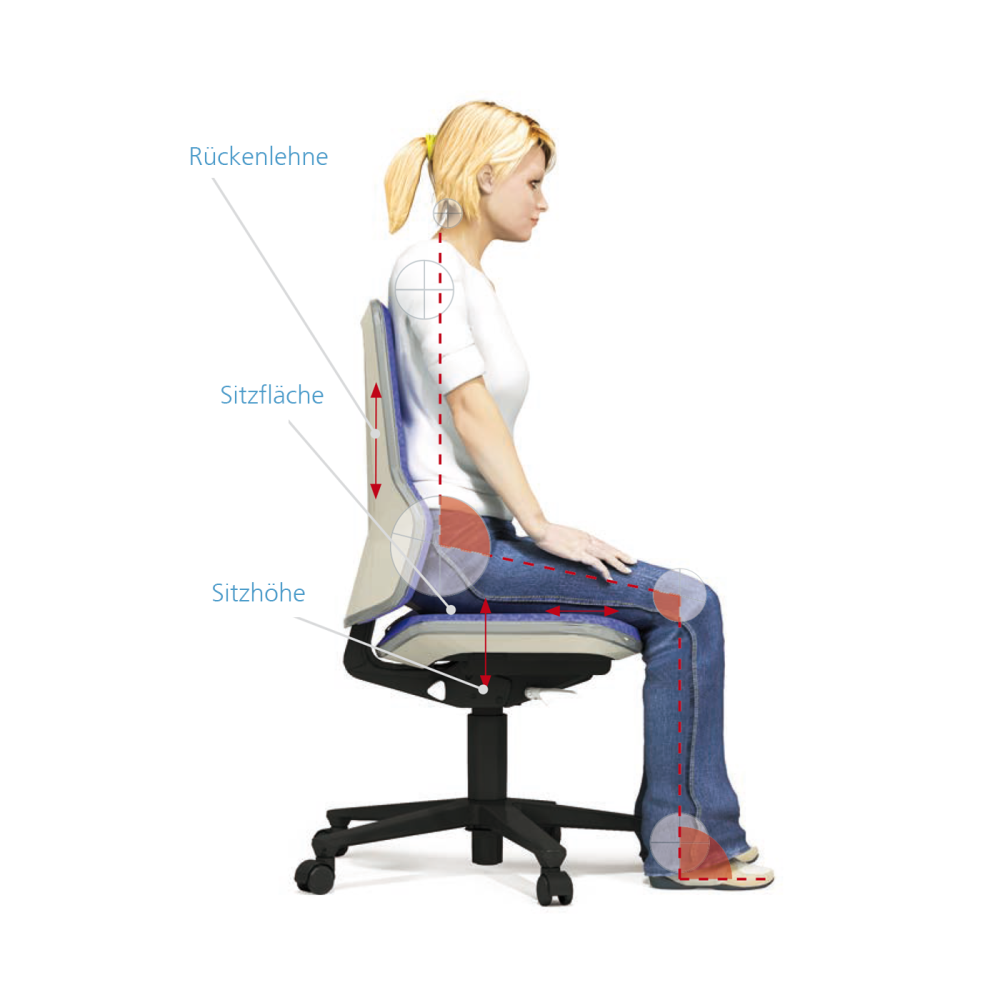
DID YOU ALREADY KNOW? - MOTIVATIONAL EFFECT
Simple production work is increasingly being replaced by more complex and demanding tasks. The demands on employees are also increasing accordingly.
A company that wants to attract and retain qualified employees must provide ideal working conditions. These start with an ideal work chair.
The latest studies show that future production systems will place new demands on work equipment, i.e. machines, devices, work tables and even work chairs. This means higher demands on technical performance features, but also on design quality.
If you want highly motivated employees who are highly productive, you have to ensure that all components of the work system contribute to this motivational effect. A high level of design and equipment quality can realise an improvement potential of up to 36%.
In addition:
A good task chair protects you from tiring too quickly at work and promotes concentration.
(Further information on this can be found in the Fraunhofer IAO study Arbeitswelt 2015 plus)
Sitting or standing?
In production and assembly, the number of purely standing or sitting workstations is constantly decreasing. Standing or sitting alone has negative consequences for the human organism and therefore negative effects on work performance due to pain, fatigue, loss of concentration and demotivation.
Compared to sitting, standing requires more energy, puts strain on the musculoskeletal system and reduces the stability of the upper body. Uninterrupted and, above all, static sitting leads to impairment of the muscles and the musculoskeletal system, while also placing additional strain on the cardiovascular system.
Dynamics through standing and sitting
Workstations where you can alternate between sitting and standing are therefore ideal.
Standing-sitting dynamics and posture changes during the work process strain different muscle groups.
This makes it possible to realise a level of movement that reduces muscle inactivity, tension and postural monotony and supports the activation of the cardiovascular system and the autonomic nervous system. This promotes a dynamic and efficient working style.
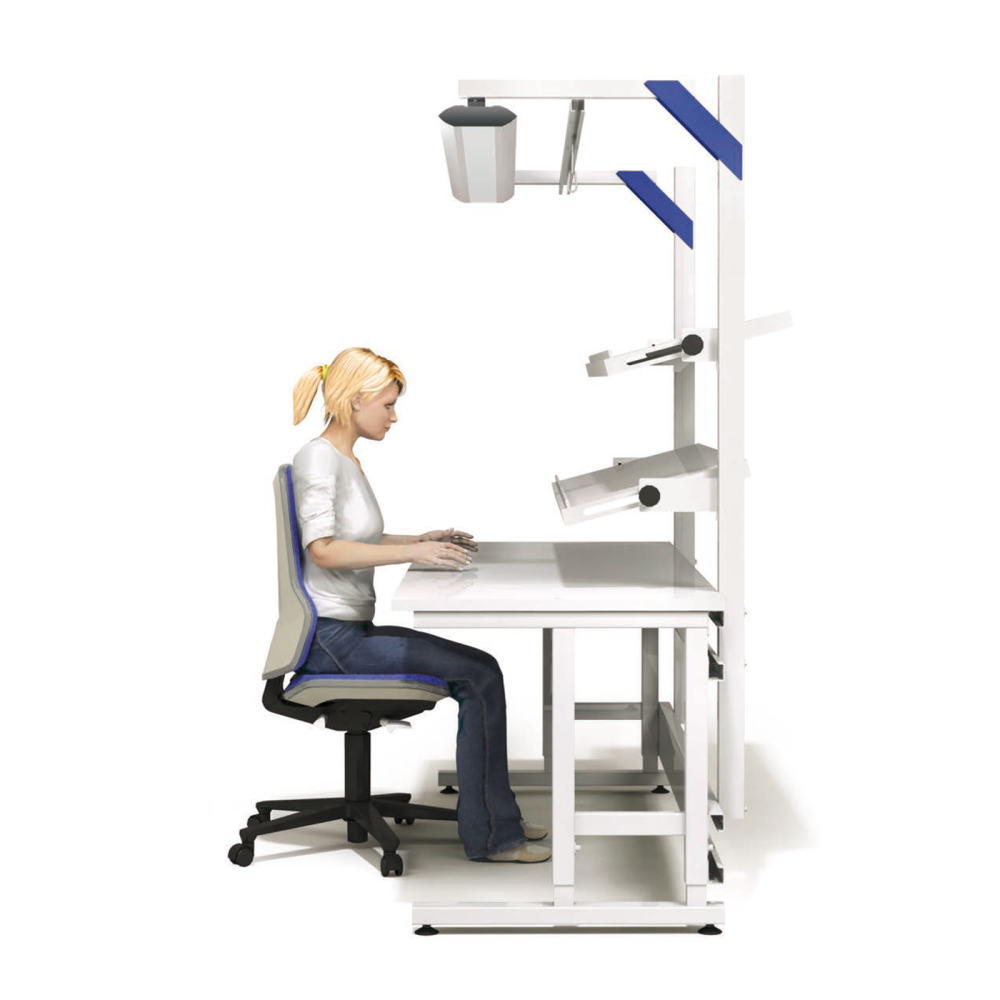
Ideally a seated workstation:
- Upper body upright
- Upper arms vertical
- Forearms horizontal
- Thigh horizontal
- Lower leg vertical
- flat ground contact of the feet
- Sufficient space for arm and leg movements
Standing workstation is ideal:
- Posture upright
- Upper arms vertical
- Angle between upper and lower arm at least 90°
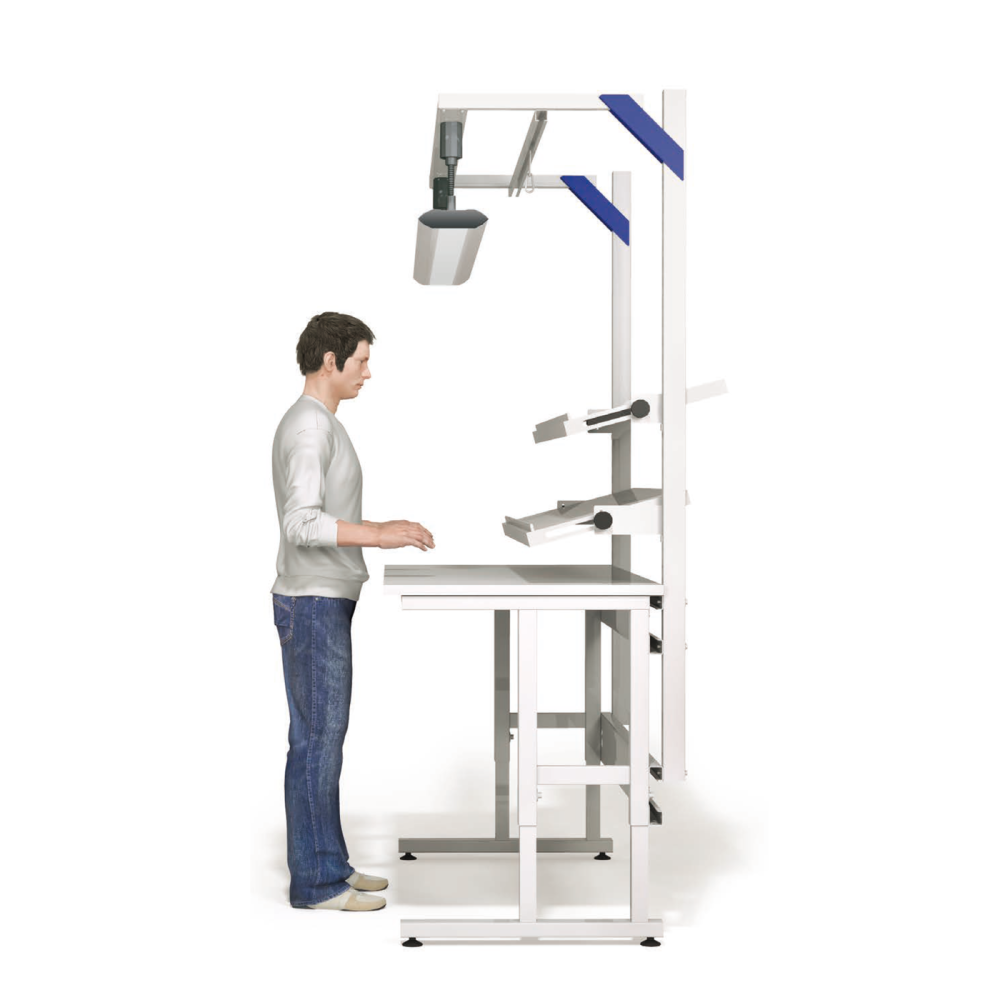
Combined sit/stand workstation
Height-adjustable assembly workstations can be adapted to individual body dimensions and the product to be manufactured.
The height adjustment should be simple and easy to operate - electric height adjusters have proven their worth.
If no height-adjustable desks are available, the desk height of a standing workstation is selected - in this case, high chairs or standing aids and suitable footrests are provided.
Optimum dynamics:
- Avoid static sitting and standing
- the individual standing phases should not last longer than 20 minutes
- 2 to 4 posture changes per hour
Ideal distribution over the working day:
- approx. 60 % working in a seated position
- approx. 30 % working while standing
- approx. 10 % targeted walking around
DID YOU ALREADY KNOW?
"Assemblers" are among the occupations with the most sick days caused by musculoskeletal disorders (approx. 25 %).
Many strains at the assembly workplace can be reduced by simple measures.
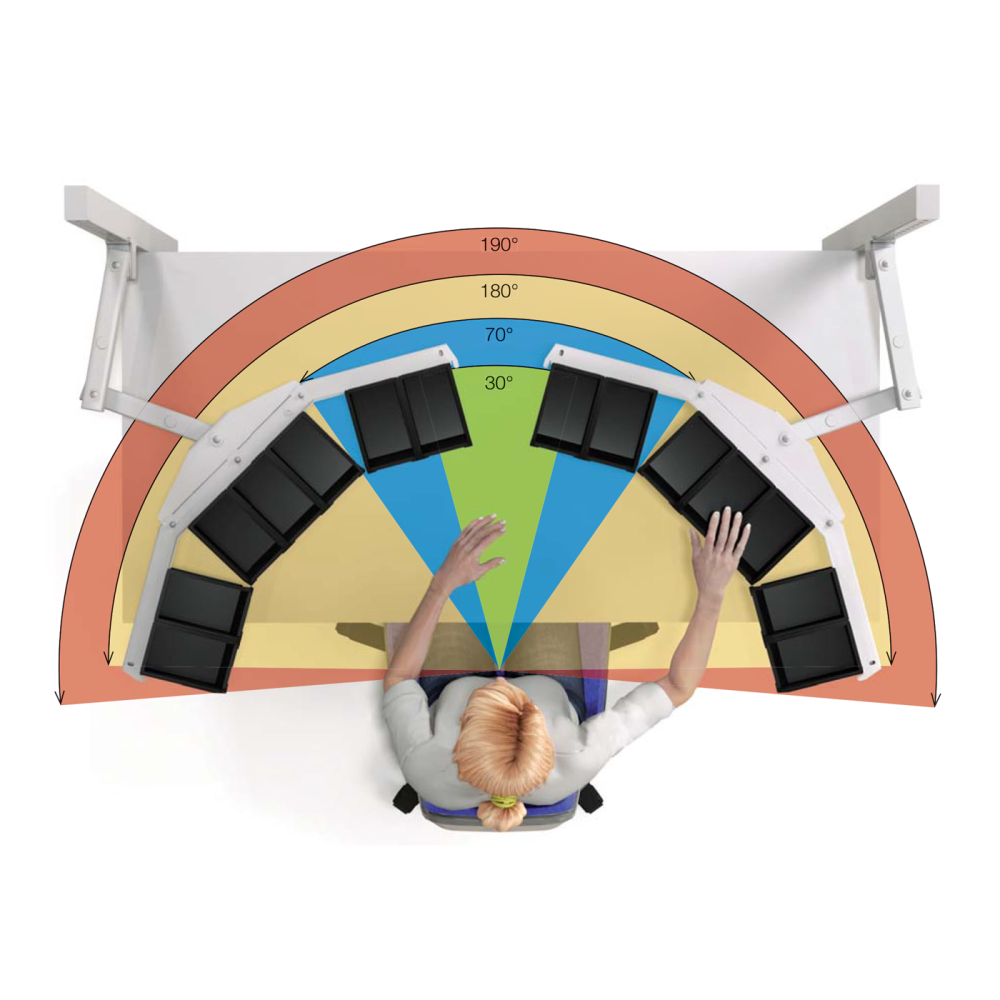
Insight into our field of vision
Zone 1:
Optimum field of vision
Zone 2:
Maximum field of vision
Zone 3:
Maximum field of vision
Zone 4:
Expanded field of vision through head movement
How to keep an overview
If the head is moved frequently while working and the eyes are constantly refocussing on objects in the working environment, this leads to fatigue, headaches or tension in the long term. The ergonomic design of assembly workstations must therefore also take the visual range and viewing distance into account.
Everything you need at a glance
A distinction is made between two areas of vision: the visual field and the field of vision.
The field of vision is the area that can be perceived - not directly fixed - without moving the eyes or head. The field of vision defines the area in which objects can only be seen and focussed on by moving the eyes when the head is fixed.
When setting up the ergonomic workstation, materials are generally not placed outside the maximum field of vision; frequently used materials are located within the field of vision.
Work tasks that require frequent eye contact are carried out in the optimum field of vision.
The ideal angle of inclination of the head and gaze when standing is 15° for the head and 30° for the gaze - relative to the horizontal. When seated, the ideal angle is 35° for the head and 40° for the gaze.
With an optimum field of vision and comfortable head tilt, the neck and eye muscles are relaxed.
The ideal viewing distance
The viewing distance depends on the respective work task - activities with high visual requirements demand a shorter viewing distance. Grip containers are always positioned at the same distance so that the eye rarely has to refocus.
Exercises for relaxed eyes
Blink more often
This distributes tear fluid across the retina and protects the eye from dryness.
Let your gaze wander
Find at least three fixed points in the room and a few outside. For example, a picture on the wall or the light switch, a tree in front of the window or a building on the other side of the street.
In between, let your gaze jump from a fixed point inside, to one outside, back inside and out again, and so on. This will prevent you from straining your eye muscles on one side.
Short relaxation
Look upwards very slowly as far as you can without moving your head. Then take a deep breath and look down as far as you can. Breathe in deeply again and repeat five times. Then do the exercise five more times with your eyes swivelling to the right and left.
The eyes circle
First circle clockwise for about a minute - then close your eyes for ten seconds and then circle in the other direction for another minute.
Particularly effective:
It is very relaxing for your eyes to simply close them for 10 seconds every now and then.
Don't forget to drink!
A lack of fluids can also be a reason for burning and dry eyes. Drink regularly and sufficiently - it's not just good for your eyes!
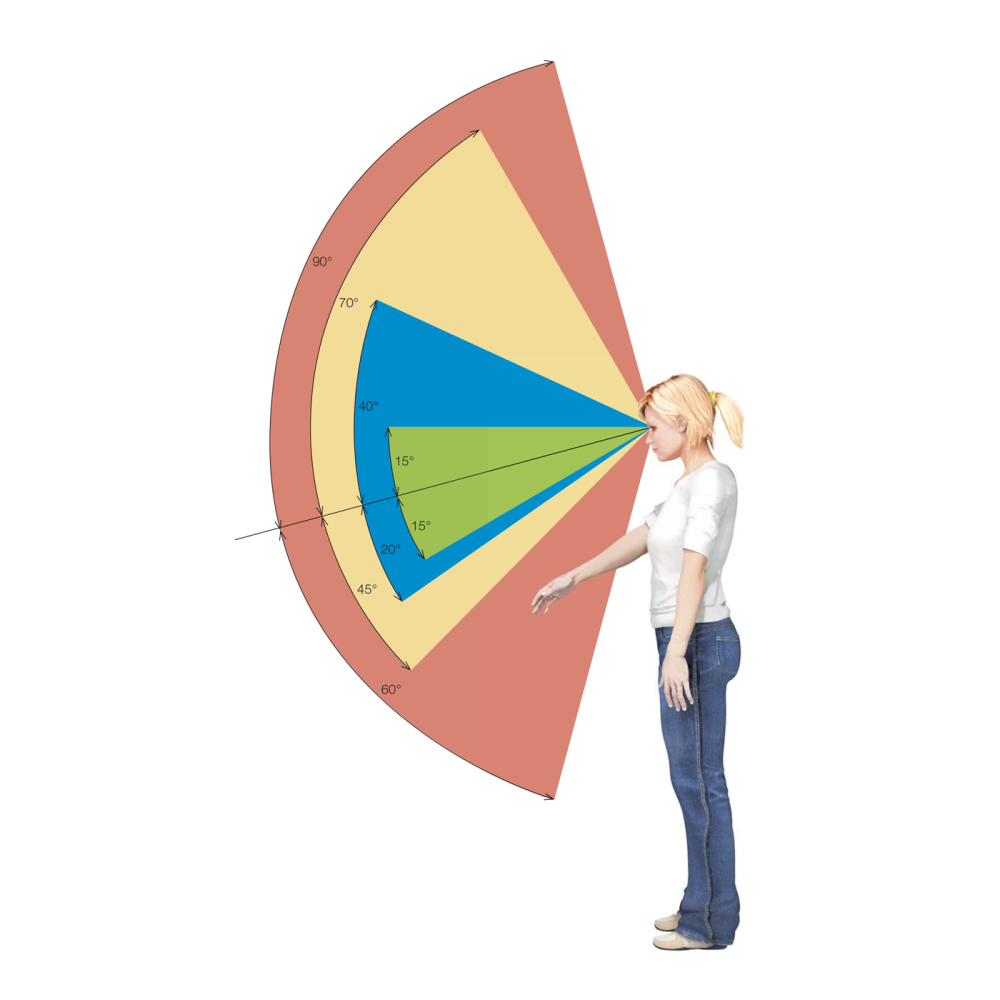
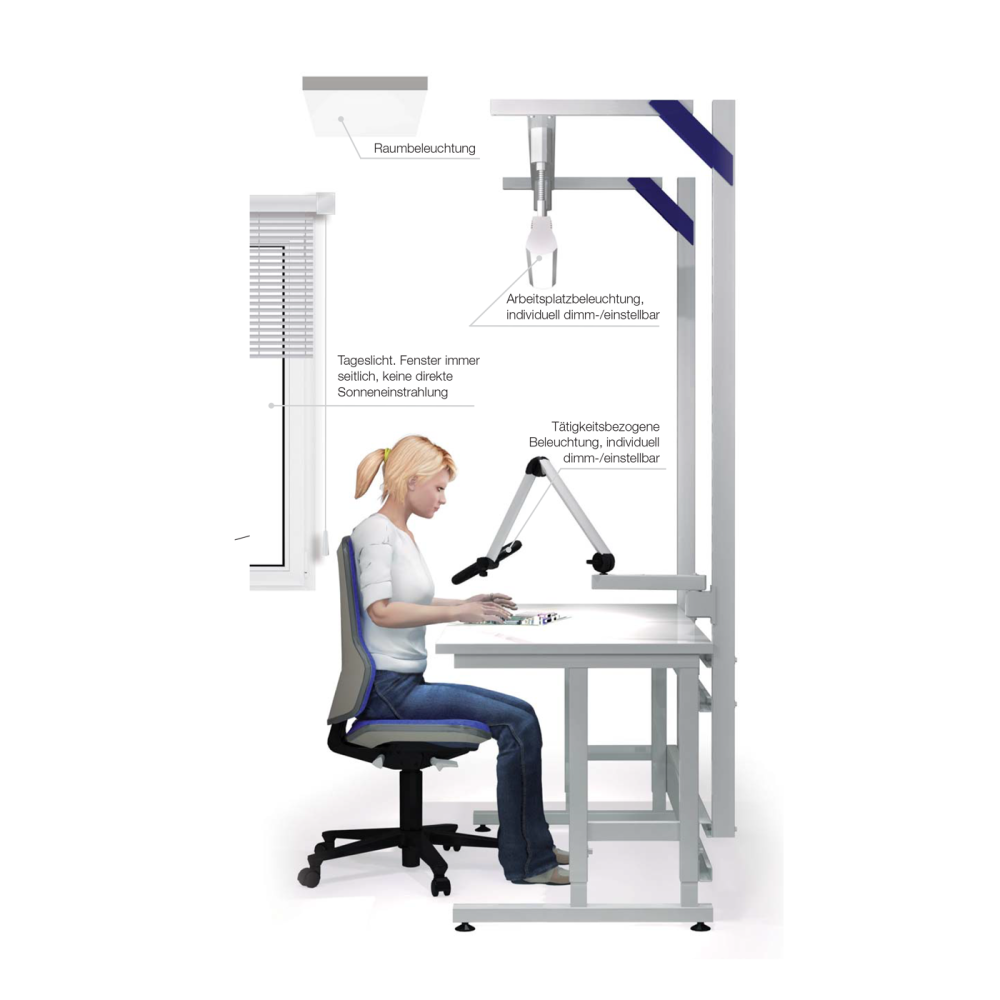
The optimum lighting for fatigue-free working
To provide optimum support for demanding visual tasks at industrial workplaces, it is very important to adapt lighting conditions to working hours, activities and individual needs.
Above all, this includes the correct alignment of the light source and the optimum setting of the illuminance. This is particularly important in changing scenarios: when working in several shifts, when alternating between finer and rougher tasks or when the workplace is occupied by several people of different ages.
A comprehensive lighting concept takes into account all light sources in the room: the incidence of daylight, the room lighting and the shadow-free lighting of the workstation itself.
The lighting level should increase continuously from the ambient lighting of the room to the lighting in the direct area of the visual task.
It all depends on the quality of light
In addition to brightness, quality characteristics such as colour rendering, colour temperature and freedom from glare and flicker also play an important role. If colour recognition is important, the light source should have a colour rendering index of Ra ≥ 90.
A colour temperature of over 5300 K (daylight white) is ideal for good contrast vision. Direct and reflected glare on high-gloss surfaces is supported by the correct positioning of the luminaires and a sensible selection of luminaire covers or louvres.
Flicker-free lighting is ensured by luminaires with electronic ballasts or LED luminaires.
DID YOU ALREADY KNOW? - Correct lighting
Light stimulates employees by suppressing melatonin production (sleep hormone) and increasing the release of "good mood hormones" such as serotonin - important factors for error-free production in shift work.
Fatigue effects can be avoided by using higher illuminance levels. Especially with regard to older employees, night or shift workers, this also has a long-term health-promoting effect. The relative need for light increases from around the age of 30. The eye media lose their permeability; the average pupil width decreases with the same illuminance - a 60-year-old employee needs twice as much light as his 20-year-old colleague.
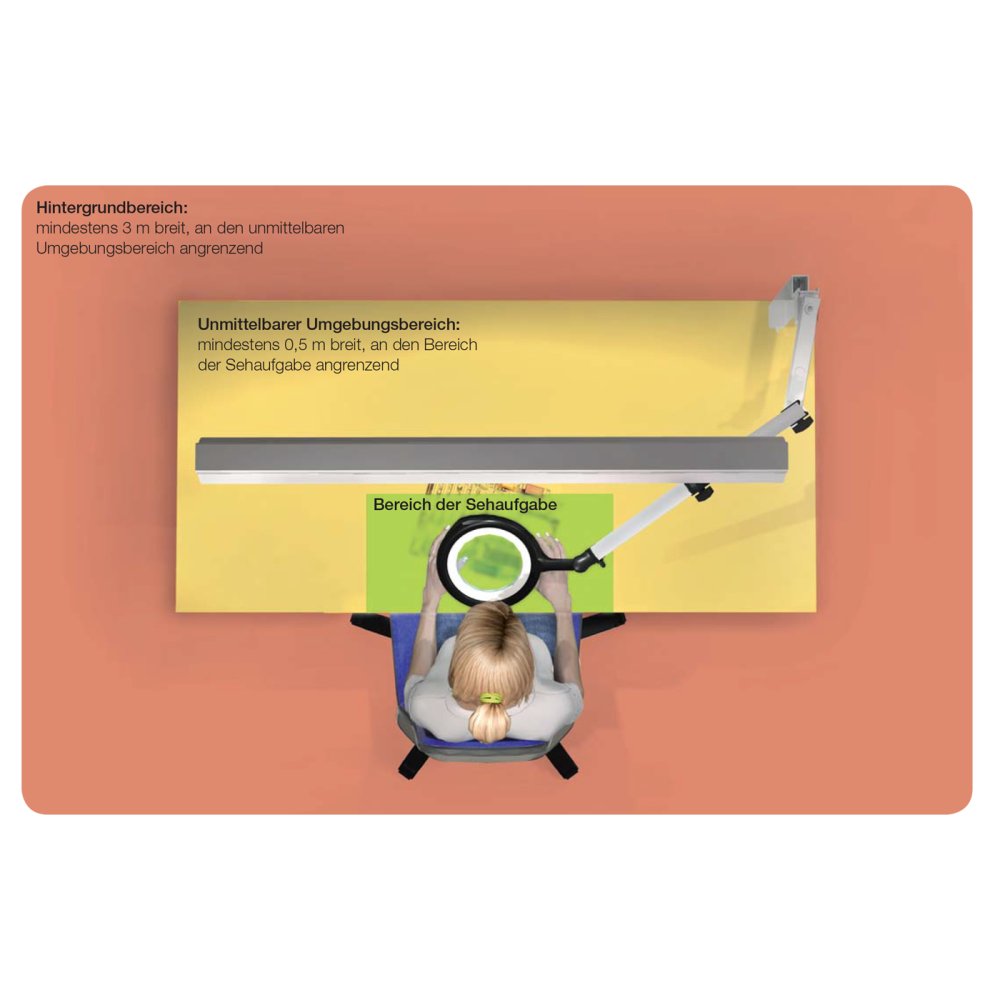
Average illuminance levels for assembly workstations
| Type of activity | Branch of industry | Visual task area | Immediate Surrounding area | Background area |
| Rough | Metal processing | 200 lx | 150 lx | 50 lx |
| Electrical industry | 300 lx | 200 lx | 70 lx | |
| Medium fine | Metal processing | 300 lx | 200 lx | 70 lx |
| Electrical industry | 500 lx | 300 lx | 100 lx | |
| Fine | Metal processing | 500 lx | 300 lx | 100 lx |
| Electrical industry | 750 lx | 500 lx | 170 lx | |
| Very fine | Metal processing | 750 lx | 500 lx | 170 lx |
| Electrical industry | 1000 lx | 500 lx | 170 lx |
Health management
"As a specialist in health matters and with a market share of over 40%, AOK Bayern is helping to shape the healthcare system in Bavaria. Over four million people place their trust in us, which is why we are particularly keen to emphasise to company management that they have a direct influence on the physical and mental well-being of their employees. Modern corporate strategies support the improvement of health in the workplace by optimising work organisation and the working environment.
The strategic and methodical aim of occupational health management is to make work healthier and promote health-conscious behaviour among employees, resulting in greater job satisfaction, a lower sickness rate and lower sickness costs. The driving force and initiator for ergonomic optimisation is the management level. A look at the connection between management and health is therefore an indispensable contribution to comprehensive occupational health management.
Knowledge of ergonomic interrelationships gives companies the opportunity to save costs and improve the quality of work simply by optimising workplaces and processes. Ergonomic restructuring has a demonstrable effect and can often be realised with relatively small changes and investments.
The initiative is therefore teamwork FORUM WORK DESIGN welcome all round. It sheds light on the factors of ergonomics from different angles so that everyone can benefit from it.
For these reasons, we at AOK Bayern have also agreed to support the PRAXISRATGEBER ERGONOMIE. As a health insurance company, we know how important education and prevention are."
Heinrich Hecht, Director of AOK Bayern,
Directorate Freising
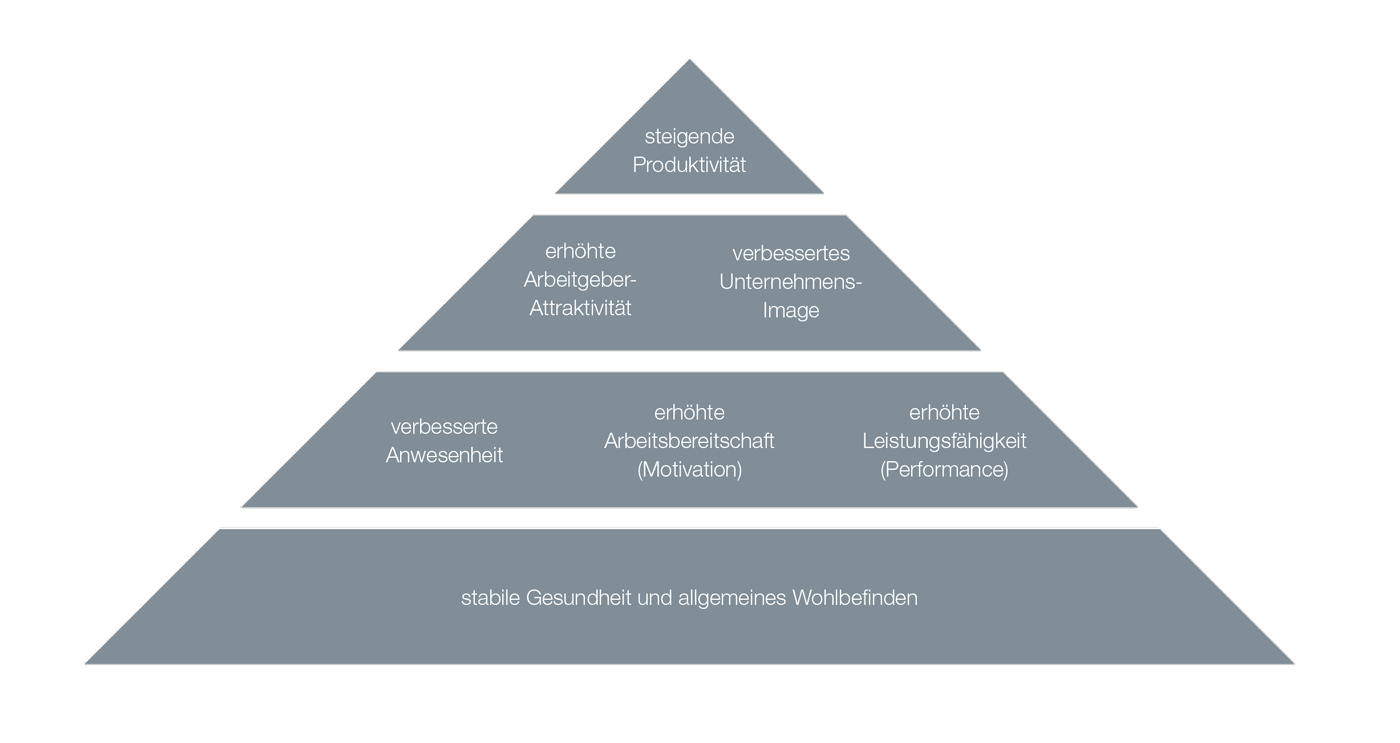


 DE
DE